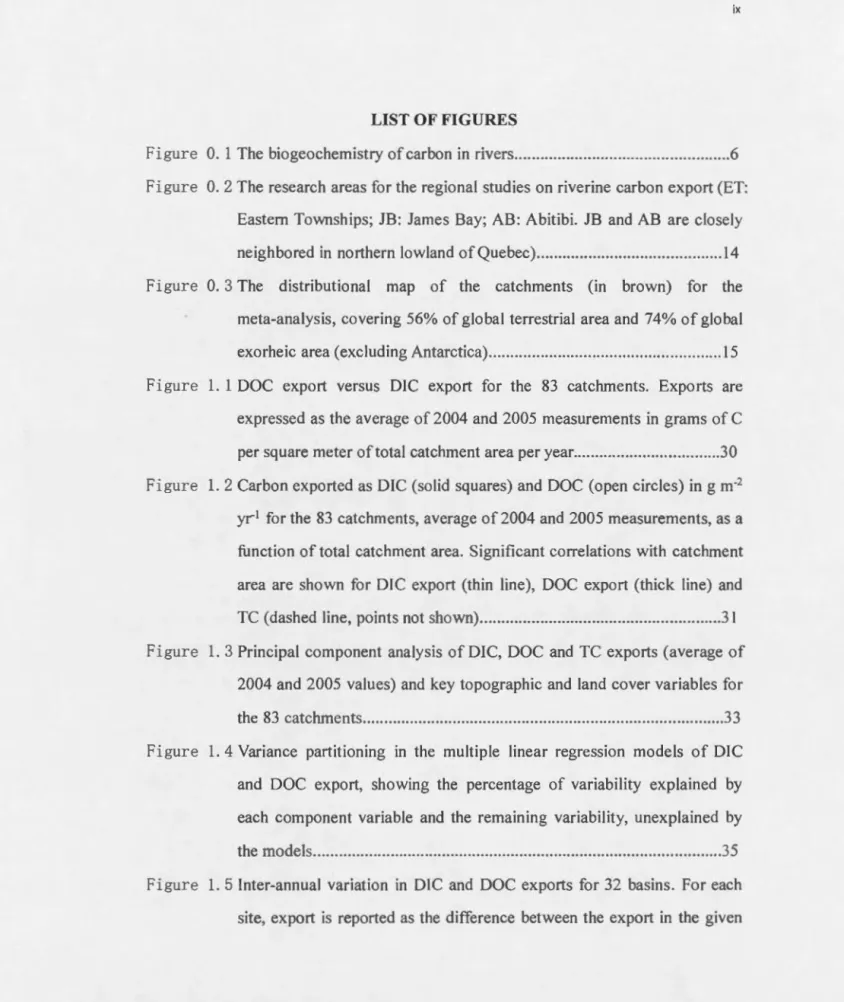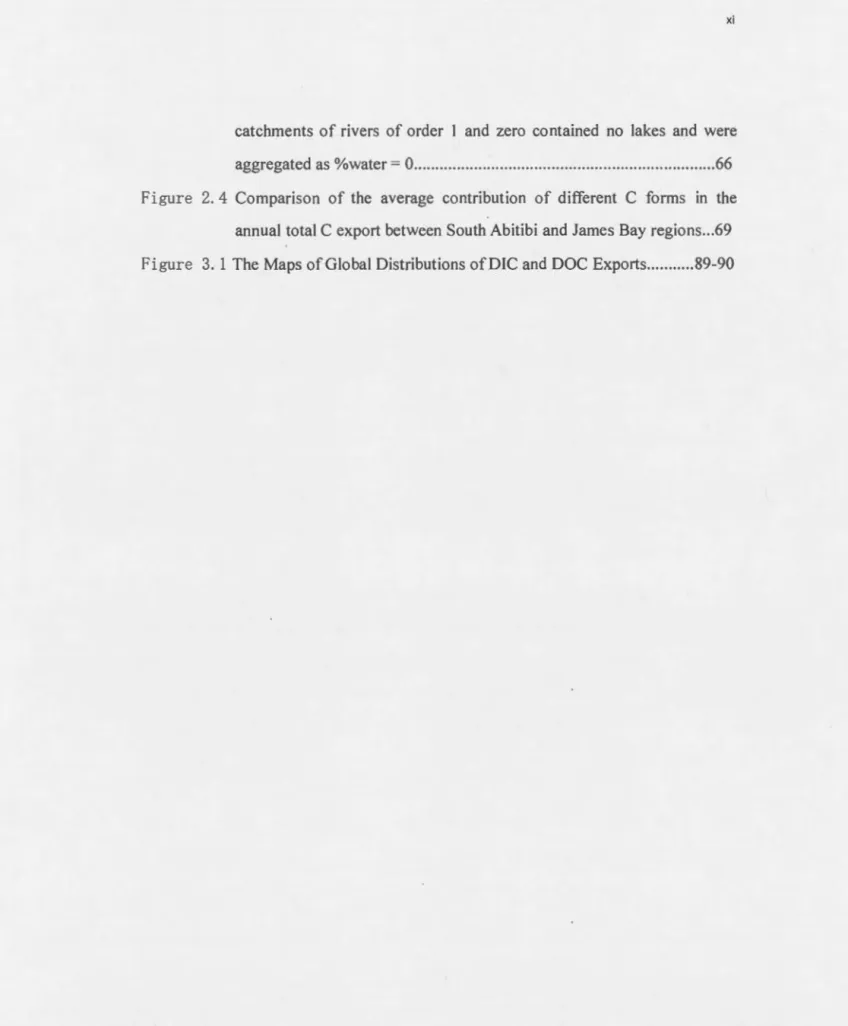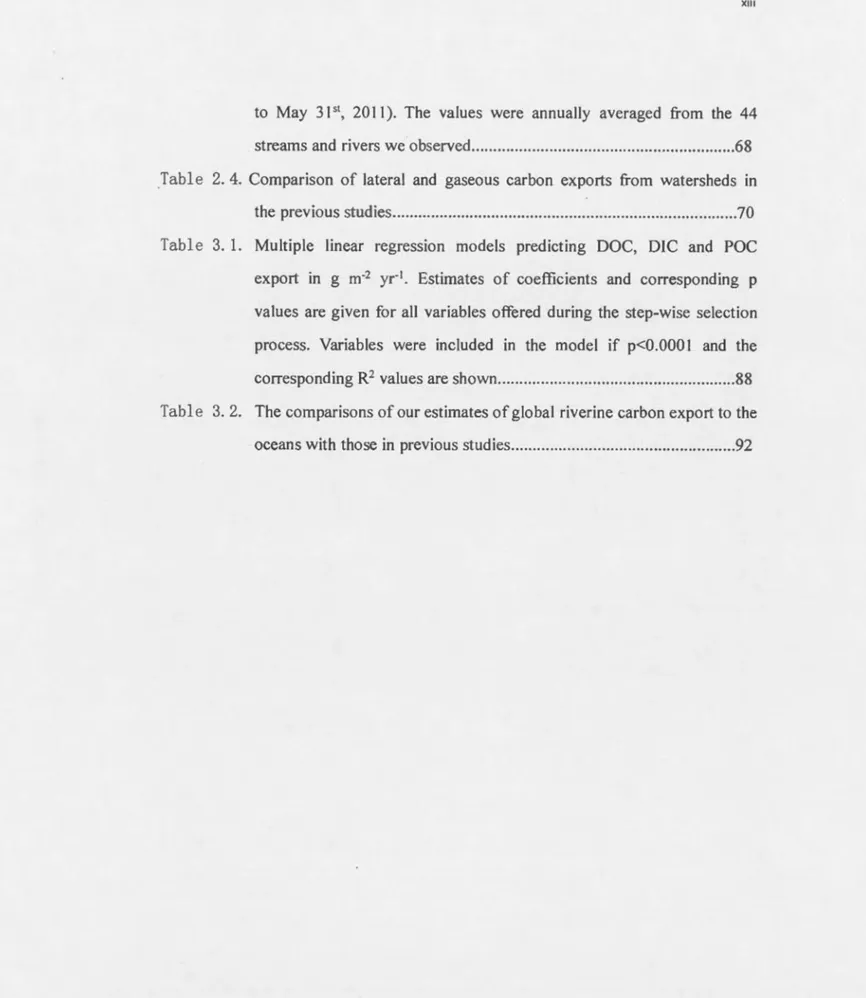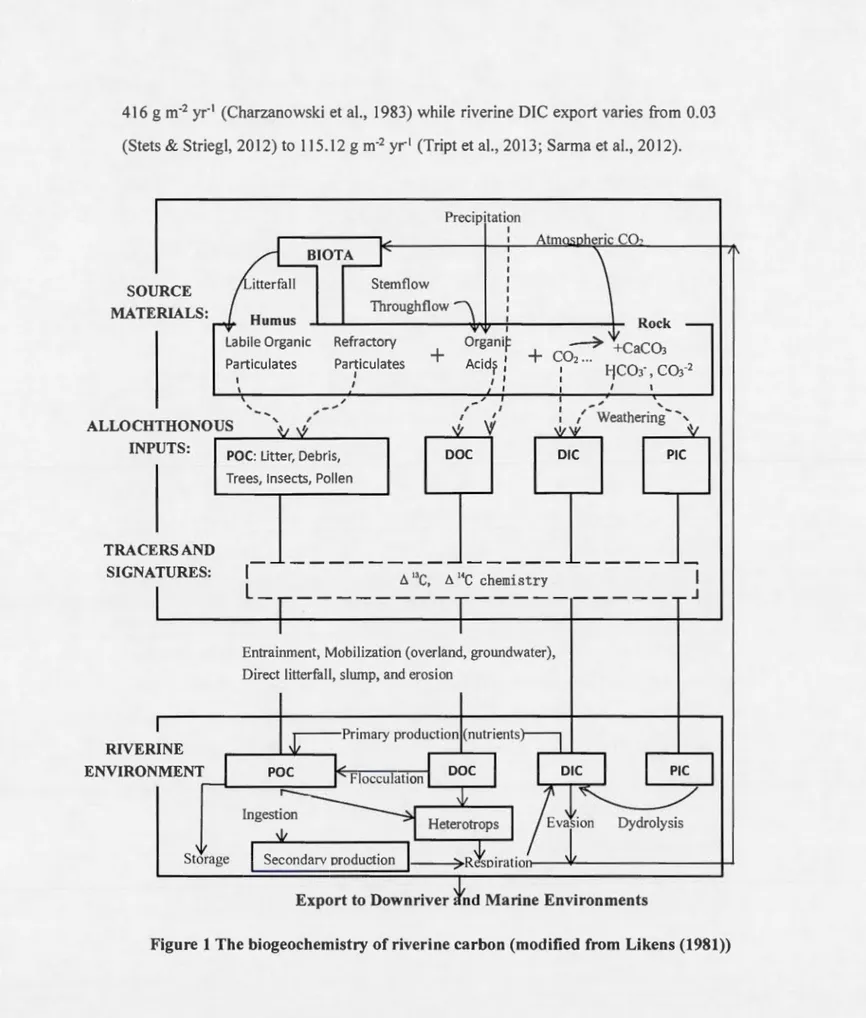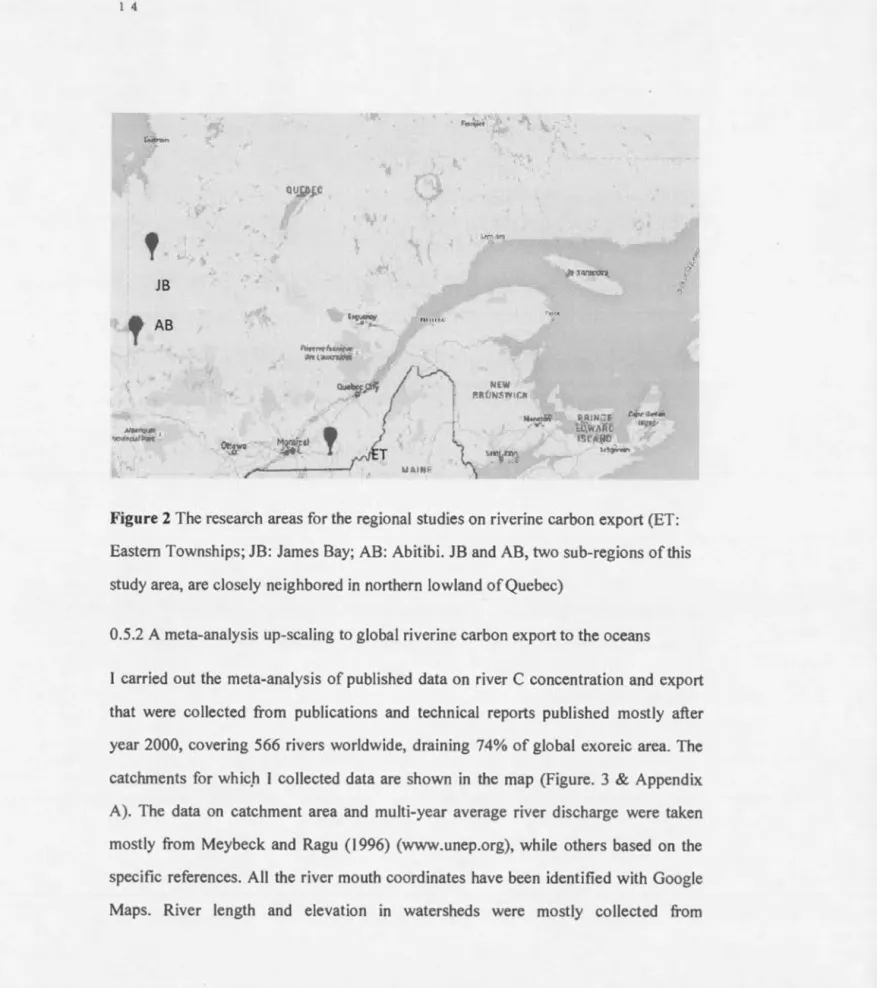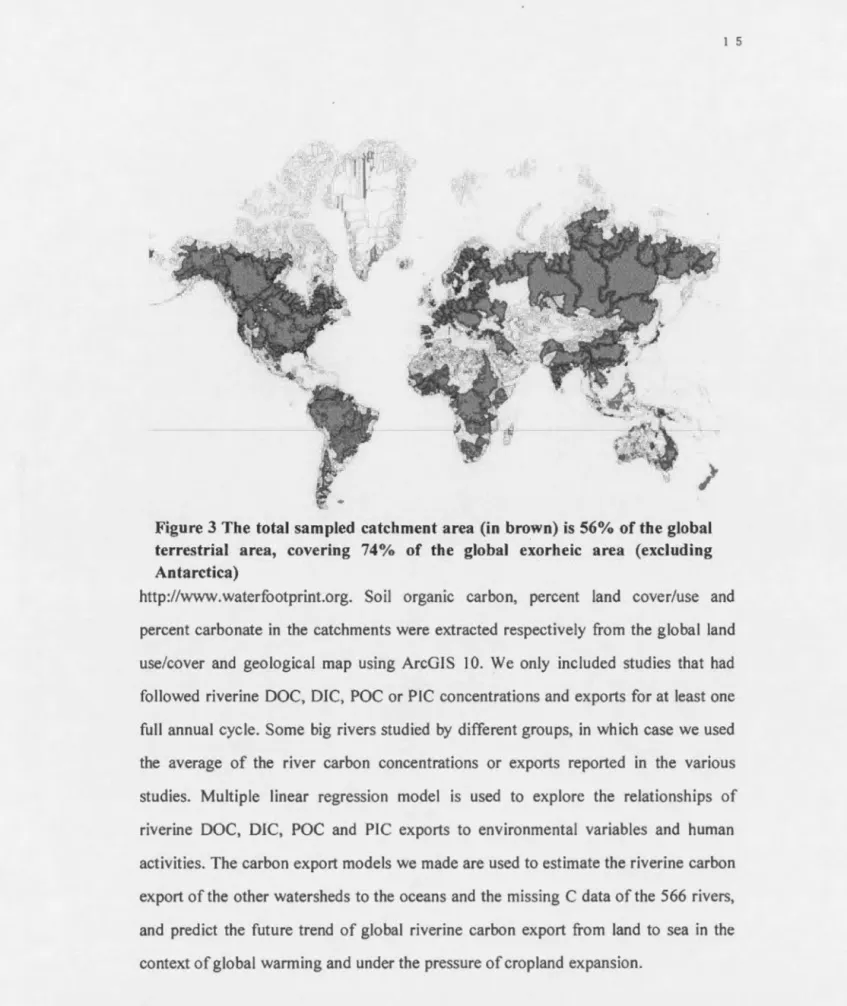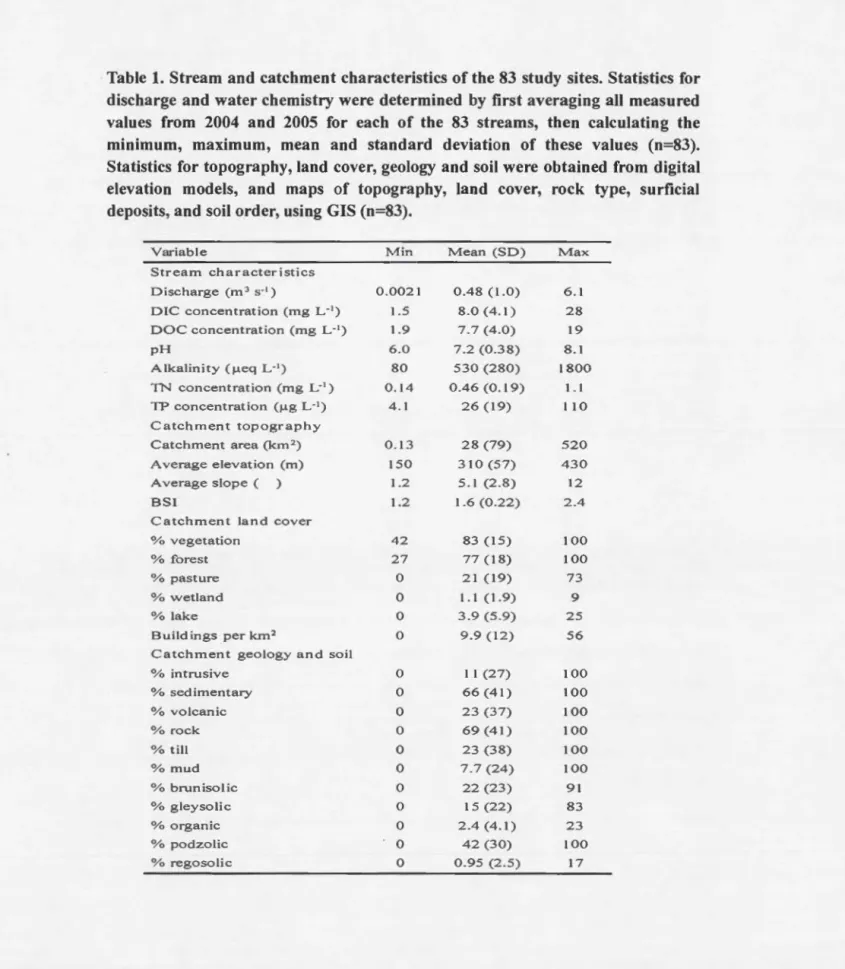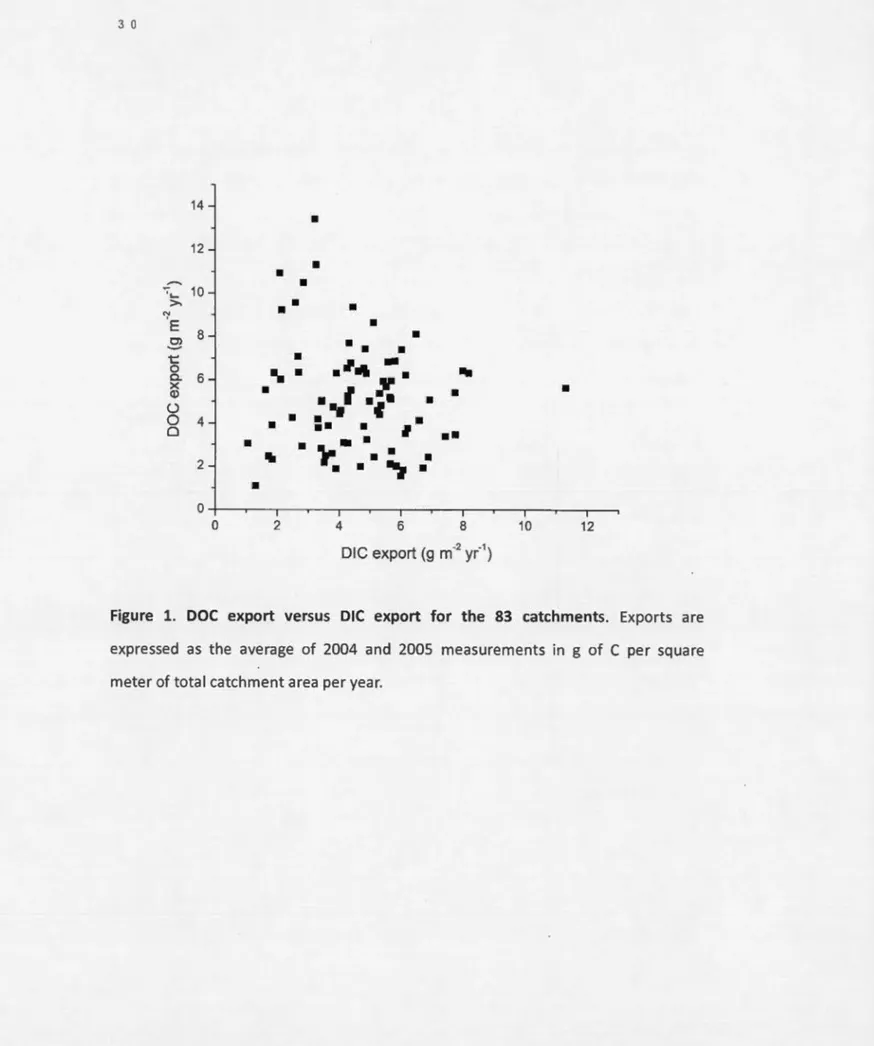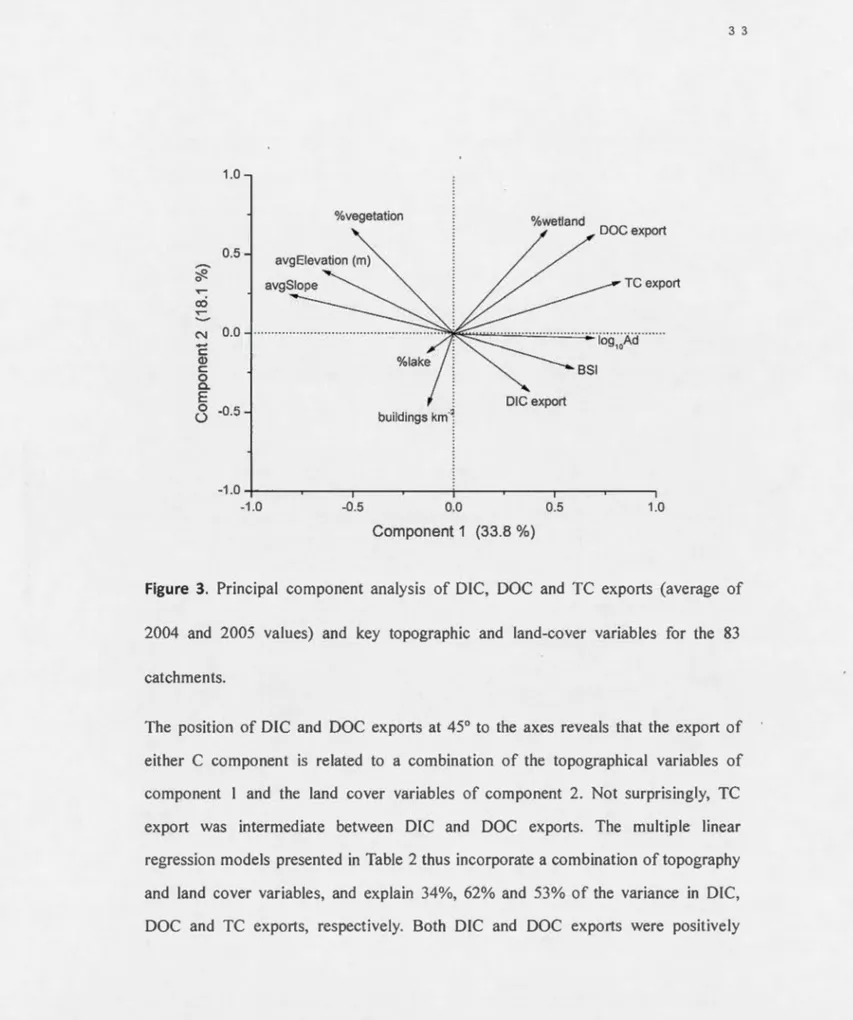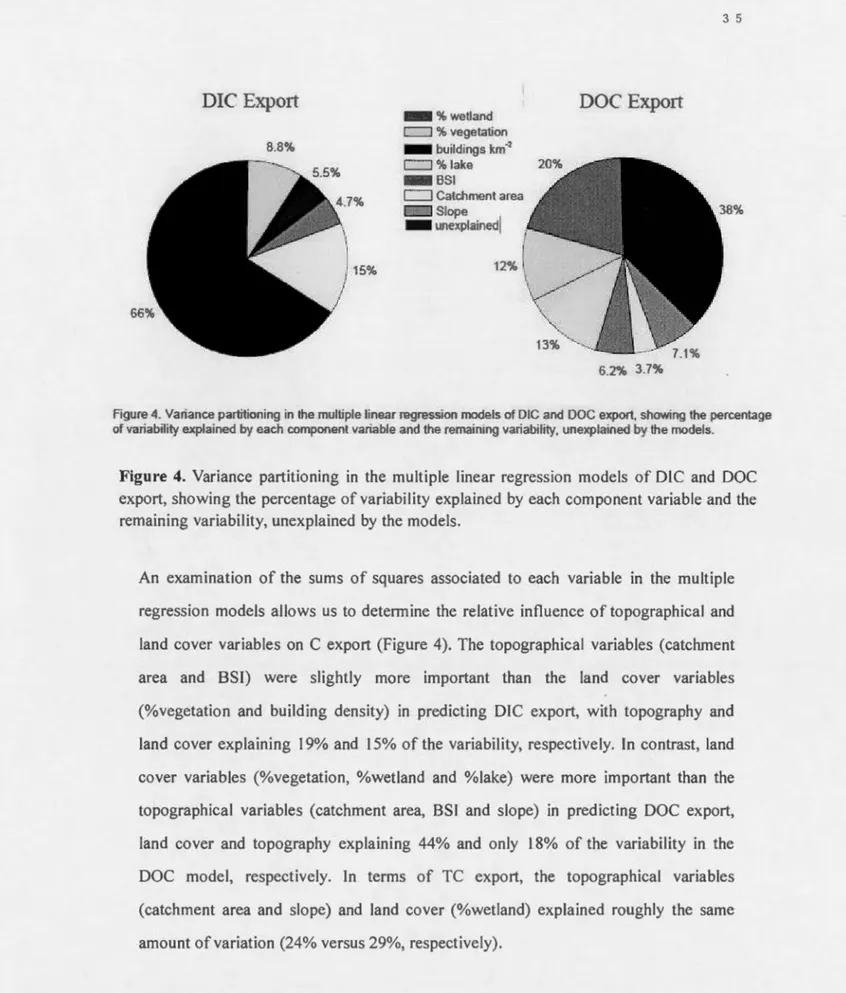UNIVERSITÉ DU QUÉBEC À MONTRÉAL
REGIONAL AND GLOBAL
PATTERNS IN
CARBON EXPORT
FROM LAND TO
WATER
THESIS
PRESENTED
IN PARTrAL
FULFILLMENT
OF
THE
DOCTORAL DEGREE IN BIOLOGY
BY
MINGFENG LI
UNIVERSITÉ DU QUÉBEC À MONTRÉAL
Service des bibliothèques
Avertissement
La diffusion de cette thèse se fait dans le respect des droits de son auteur, qui a signé le
formulaire Autorisation de reproduire et de diffuser un travail de recherche de cycles
supérieurs (SDU-522 - Rév.0?-2011 ).
Cette autorisation stipule que
<
<conformément
à
l'article 11 du Règlement no
8
des études de cycles supérieurs, [l
'auteur] concède
à
l'Université du Québec
à
Montréal une licence non exclusive d'utilisation et de
publication de la totalité ou d'une partie importante de [son] travail de recherche pour
des fins pédagogiques et non commerciales
.
Plus précisément
,
[l
'auteur] autorise
l'Université du
Québec à Montréal
à reproduire
, diffuser, prêter, distribuer ou vendre des
copies de [son] travail de recherche
à
des fins non commerciales sur quelque support
que ce soit
, y compris l'Internet. Cette licence et cette autorisation n'entraînent pas une
renonciation de [la] part [de l'auteur]
à
[ses] droits moraux ni
à
[ses] droits de propriété
intellectuelle. Sauf entente contraire
,
[l'auteur] conserve
la
liberté de diffuser et de
commercialiser ou non ce travail dont [il] possède un exemplaire.
»
UNIVERSITÉ DU QUÉBEC À MONTRÉAL
PATRONS R
ÉG
IONAUX
ET
MONDIAUX D
E L'EXPORTATION
DE
CARBONE
D
E
LA TERRE À
L'EAU
THÈSE
PR
ÉSENTÉE
COMME EX
IG
ENCE
PARTIELLE
DU DOCTORAT
E
N BIOLOGI
E
PAR
MJNGF
E
NG LI
iii
ACKNOWLEDGEMENTS
1
wo
uld like
to express
my deep and
sin
cere gratitud
e
to
the
many
peo
ple
who
h
e
lped
me
to
bring
this
research project to fr
uiti
o
n,
directl
y or indirec
tly. First of
a
li
,
1
.
would
lik
e
to tha
nk my
PhD
sup
ervi
sors,
Professer Paul
A. del Gio
rgio and Professe
r Yves
T.
Prairi
e,
fo
r providin
g
me the opportunity of PhD in
aquatic
biogeoc
h
emi
stry.
1
am
dee
ply grateful for the
ir warm-hearted
h
elp
,
in
s
i
ghtful profess
i
o
na
li
sm,
va
luabl
e
guid
a
nc
e and tin
ancia
l
suppo
rt througho
ut
the
projec
t
and my e
ntir
e
PhD program.
The
ir patience,
und
e
rstanding and
e
nco
uragement
carri
ed me on thro
ugh these
impo
rtant
ye
ars of my
!if
e and
l
et me
l
earn how
to shape
myse
l
f
a
goo
d
sci
enti
st in
future
.
Witho
ut them,
this
di
ssertation
wo
uld not have
been poss
ibl
e
.
ln
a wo
rd
,
m
y
gratitude to the
m
is rea
ll
y
unuttera
ble
!
1
would
lik
e
to
thank the co
mmitt
ee
members,
Ors C
h
a
nghui Peng, Jo
n
athan J. Co
l
e
and
J
ea
n-Franço
i
s
Hé
li
e, fo
r
the
ir
ve
r
y
he
lp
ful
, va
lua
ble
comme
nts and
suggesti
ons
to
improve the qu
a
lity of
this thesis
.
1
am
also deeply
ind
ebted to a
li my colleag
ues,
the
l
ab me
mbe
rs of the
the
lndu
stri
a
l
Resea
rch
Chair
in
Carbon Biogeoche
mi
stry
in
Bo
r
ea
l
Aqu
atic Systems (CarBBAS)
and the
UN
ESCO
Cha
ir
in Glo
ba
l
E
n
viro
nmenta
l
Chan
ge,
he
ld
res
pective
l
y
by
Paul
de
l
Gio
rgio a
nd Yves
T.
Prairie, fo
r their he
lp
in the fie
ld
,
in th
e
l
a
b,
a
nd
in my
daily
!i
fe
: Thanks
to Jean-
Franço
i
s
Lapie
rre,
Do
minic
Y
ac
ho
n, Audrey Ca
mpeau
,
Matthew
Bagard
,
Ma
rie
-
Ève Ferland
,
Franço
is
Guill
emette,
Li
sa Fauteux,
Véroniqu
e
Du
charm
e
Ri
e
l
,
Nico
l
as
Fo
rtin-St-Ge
l
a
i
s,
Jerome Co
mt
e,
Lenni
e
Boutet,
Maril
yne
Robido
u
x,
Juan-Pablo
Nin
a
-
Garcia,
Caro
lin
a Ga
rcia-Chavez,
Cy
nthia So
ued,
Ryan
Hutchin
s,
Shoji
T
hottathil
,
Roy Na
has and
Sara
Me
rcier Bla
i
s
. Thanks
to pos
tdoctoral
fe
ll
ows,
Ma
rtin Berggre
n,
Cri
stian
Teodoru
,
Tehri Ras
il
o,
Clara
Ruiz
-G
onza
l
ez,
iv
Tonya
DelSontro
and Adam
Heathcote
for va
lu
ab
l
e experience and
new
ideas they
gave
us.
Special
thanks
to Ali
ce
Parkes
and
Annick St-P
ierre
,
as stro
ng
pillars
of our
research team,
who are
be
able to
run fieldwork, laboratory,
logistics, financial
and
human resources,
easily and smooth
l
y
,
thus
guaranteeing an excellent environment
for
our
work and
study
.
1 also great
l
y
thank Profs
. Alison Derry and Beatrix Beisner
for
their kind help
with
my PhD
study.
1
wou
Id
also
lik
e
to
extend
my
appreciat
ions
to
the
funds
that materialize
our
research
group of
multiculturalism because nothing
would
have been possible
without
the
significant
financial
support. T
hanks
to
Fonds
de recherche du Québec
-
Nature
et
technologies
(FRQNT)
,
Natural
Sc
iences and
Engineering
Research
Cou
nci
l of Canada (NSERC) and
Hydro-Quebec,
and
Groupe
de Recherche Interuniversitaire
en Limnologie et en Environnement Aquatique
(GRJL)
.
Finally,
1 wo
uld lik
e
to thank my family,
espec
iall
y
my
wife
,
Jinxia Wang,
who
a
l
ways
understands,
encourages and supports
me to finish my PhD
study
,
and
my
little
son
,
Alexander
,
and
my daughter,
Blair,
who
bring
a
l
ot of l
aughter and energy
to my life
,
further strengthening
my
confidence
in my PhD
study. Thanks
to my
parents for their
giving
me
encourages and
blessings
over
telephone,
rnaking my
lif
e
v
CONTENTS
LIST OF F
IGURES ...
...
....
...
....
..
....
...
...
..
ix
LIST OF TABLES
..
...
..
...
...
....
...
...
...
...
...
.... x
ii
ABBREV
IATIONS AND ACRONYMS
...
...
... xiv
ABSTRACT ...
...
..
...
...
...
...
....
... xv
R
ÉSU
MÉ
..
..
...
...
...
..
...
.... xvii
INTRODUCTION
...
...
..
...
....
...
...
...
... !
0.
1
T
he ro
le and
importance of river system
in
carbon cyc
lin
g ...
... l
0.2 Environmental contra
is on
riverine
carbon export from watersheds at
landscape
scale ...
...
...
...
...
...
...
..
...
...
...
...
...
3
0.3 Tota
l carbon export from watersheds to r
iver systems
...
...
... !
0
0.4 Objectives of the thesis
..
...
...
...
...
....
...
..
...
...
.
ll
0.5 Genera
l scopes and approaches ...
...
...
...
...
...
...
... 12
0.5.1
Regional
rive
rine carbon export fi·om
notthern catchments ...
... 13
0.5.2 A meta-analysis up-scaling to g
lobal r
iver
in
e carbon export to the
oceans
.. l
4
CHAPTER
1
THE RELATIVE
INFLUENCE OF TOPOGRAPHY AND LAND COYER ON
JNORGANIC AND ORGAN
IC CARBON EXPORT FROM CATCHMENTS
IN
SOUTHERN QUEBEC, CANADA
...
..
...
....
...
...
...
...
...
...
.
!?
1. 1 Abstract. ...
...
...
...
....
..
...
...
...
...
...
...
..
..
...
....
..
17
1.2
lntroduction ...
...
..
...
...
..
...
...
..
....
...
....
...
..
...
... l
8
1
.3
Materials and
methods
...
....
...
...
...
21
1.3.
1 Study area
...
...
2
1
1.
3.2 Samp1ing, ana
lyses and ca
lcu
lations
...
....
...
...
...
...
...
....
...
...
23
1.3.3
Catchment topography and
land cover ...
...
..
...
...
... 27
vi
1.3.4 Statistical ana
lyses ...
..
....
...
....
... 28
1.4
Results
...
...
...
...
...
... 29
1
.4.1 Carbon export.
...
... 29
1.4
.2
Factors intluencing carbon export ... .32
1.4.3
lnter-annual variation
in
carbon export ....
...
...
.36
1.5
Di
sc
ussion ...
...
..
..
...
...
...
...
....
...
...
...
....
....
....
..
..
.
38
1.5.1 Drivers of terrestrial carbon expo
rt
to aquatic systems ...
... .40
1.5.1.
1 Drivers of
DfC
Export... ...
..
...
....
...
...
...
... .4
1
1.5.
1.2
Drivers of
DOC Export... ... .43
1.5.1.3 Drivers ofTC Export. ...
...
..
...
..
.
...
...
...
.44
1.5.2
Influence of
land cover on
the
fonns of carbon exported ...
..
... .46
1.5.3 Inter-annual variatio
n
in
carbon export...
...
....
...
... .48
CHAPTER 11
MAGNITUDE AND COMPOS
IT
ION OF CARBON EXPORT
D
FROM
BOREAL
CATCHMENTS
TO
RIVER
SYSTEMS
IN
NORTHERN
QUÉBEC,
CANAD
A ...
...
...
...
...
...
...
...
... 5
1
2.1
Abstract. ..
...
...
...
...
...
...
...
...
...
...
..
...
. 5
1
2.2 Introductio
n
..
...
..
...
...
...
....
...
....
...
...
...
...
...
...
52
2.3
Materials and
methods
...
...
..
...
...
...
..
... 55
2.3.
1 Stud
y area ...
...
...
.
...
...
...
...
... 55
2.3.2 Samplin
g and chem
ica
l ana
lyses ...
...
...
.
...
...
... 57
2.3.3
Discharge and
DOC and
DIC flux
calcul
ations ...
...
... 57
2.3.4 Aquatic gas emiss
ions ...
...
....
... 60
vii
2.3.6 Statist
ica
l Ana
lyses
...
...
....
...
...
....
...
6
1
2
.4 Res
ults
...
...
....
...
...
....
...
...
...
...
6
1
2.4.
1 Ri
veri
ne
DOC a
nd DI
C expo
rts ...
...
....
....
....
...
....
....
....
6
1
2.4.2 Waters
hed aquatic C0
2
a
nd CH4 emissions
...
...
...
..
...
63
2.4.3 Tota
l C
export from boreal catchments
...
...
...
...
64
2.5 DI
SCUSS
IONS
...
...
...
69
2.5.
1 River-mediated DOC
,
DIC and C0
2
loss from
landscapes
...
...
...
69
2.5.2 Magn
itude and composit
io
n of
total C export ...
...
...
73
2.5.3 Cross-regio
nal d
ifferences
in th
e
mag
nit
ude and co
mp
os
itio
n
of C
export
...
...
75
2.5.4
Im
pli
catio
ns to terrestr
ia
l C
budgets
...
...
...
...
...
76
C
HAP
TER Ill
A GLOBAL ANALYS
IS OF RI
V
ERINE CARBON
EXPORTTO THE OCEANS
3.
1
Abstract ....
..
.
...
...
...
....
..
...
...
81
3.2 ln
troduct
io
n
...
...
...
...
...
...
..
..
....
...
....
...
82
3.3
Resul
ts and discuss
ions ...
..
..
...
...
84
3.3
.1 Dri
vers of rive
rine C expo
lt ...
...
...
...
...
..
..
...
...
...
84
3.3.2 A new estimate of globa
l riverine C export to the
oceans ...
...
89
3.3.3
Past and future
effects ofanthropogenic disturbances
on g
loba
l
riverine C
ex
port
...
...
93
3.4 Met
hods
...
....
...
...
...
...
....
....
....
....
...
...
95
CHAPTER
IV
CONCLUS
ION
S
..
...
...
..
...
...
97
4.
1 Main
co
ntributio
ns ...
...
...
...
...
97
4.2 Ma
in
innovations ...
...
...
.
.
....
... 1
0
1
viii
4
.3
lm
p
o
rt
a
nt
impli
ca
ti
o
n
s
.
..
.
...
.
...
.
..
.
..
..
..
.
...
.
.
.
...
..
...
.
...
.
.
.
..
.
.
...
....
..
...
..
...
.
.
.
....
!
0
3
REFERENCES ...
...
...
....
....
...
...
....
...
...
...
... ]
07
ix
LIST OF FIGURES
Figur
e
O. 1 The
biogeochemistry of carbon
in
rivers
...
...
..
...
...
...
6
Figure
O.
2 The research areas for the regional studies on riverine carbon export (ET:
Eastern Townships;
JB: James Bay;
AB: Abitibi.
JB
and AB are closely
neighbored in northern lowland ofQuebec) .
..
...
..
...
.
.... l4
Figur
e
O.
3 The
distributional map
of
the
catchments (in
brown) for the
meta-analysis, covering 56% of global terrestrial area and
74% of global
exorheic area (exc
lud
ing Antarctica)
...
...
...
...
... l5
Figure
1.
1 DOC
export versus
DlC
export for the 83 catchments.
Exports
are
expressed as the average of 2004 and 2005
measurements
in grams of C
per square
meter of total catchment area
per year.
...
...
..
...
30
Figur
e
1.
2
Carbon expotted as DIC
(solid squares) and
DOC (open circles)
in
g
m·
2yr·' for the 83
catchments
,
average of 2004 and 2005 measurements, as a
function of total
catchment area. Significant corre
l
ations with catchment
area are shawn for
DIC
export (thin
tine)
,
DOC
export
(thick
tine)
and
TC (dashed
tine
, points not shown)
...
...
... 31
Figure
1.
3
Principal
component analysis of DIC,
DOC and TC exports (average of
2004 and 2005 values) and
key
topographie and
land
caver variab
l
es for
the
83 catchrnents
.
...
...
...
...
...
..
...
...
.33
Figur
e
1. 4
Variance
partitioning in
the
multiple linear regression models
of DlC
and
DOC
export, showing the
percentage
of variability explained
by
each component variable and
the remaining
variabi
li
ty
,
unexplained by
the rnodels
...
...
.
.
.
.
...
.
...
.
..
...
..
...
.
.
.. 35
Figur
e
1.
5
lnter-annual
variation
in DIC
and
DOC
exports for
32
basin
s.
For each
x
year and the 3-year average ex
port for th
at site (in
g
m-
2yr-
1).The
mean
di
ffe
rence
is the sma
ll
squ
are within the
larger 75
1hpercentil
e
box,
with
9Yh
perce
ntile whiskers,
a median line,
and
asteri
sks
fo
r maximum
and
minimum
va
lues.
Diffe
rent letters w
ithin
a
pane
l indicate s
ig
nificant
di
ffe
re
nces among yea
rs (o
ne-way ANOV
A and Tukey-Krame
r post-hoc
test) ...
...
..
..
...
...
...
..
...
...
...
...
....
...
...
...
...
...
.... 3
7
Fi
gure
1.
6 Carbon ex
port
as
the sum
of DIC ex
pott
and DOC expo
rt in
g
m-
2yr-
1and the
DI
C/DOC export ratio ve
rsus %vegetation
fo
r two exa
mple
wat
ersheds, an in fl
ow to
Lac d
'
Arge
nt
(pan
els A and
C)
and
a
n in fl
ow to
Roxton Pond
(pane
ls
B
and 0
). The current
vegetation
cove
rage of the
catchment is
indica
ted by a
n "X"
in
each pane1... ...
....
... .48
Figure
2. 1 Fig
ure.
1 a.
Reg
io
nal daily
runoff (mm d-
1)
fo
r the sampling yea
r (201 0),
with the error bars (SE),
averaged
(fro
m the
da
ily
disc
harges of
six
strea
ms and
rivers
during the wat
er
yea
r
of our
observatio
n
(J
une
1
s
t,
2010 thro
ugh May 3 JS
1,
2011
).
b.
Relationships
between
estimated
and
meas
ured discharge for
the 44 studied rivers
....
..
...
..
...
..
..
..
..
..
..
.
59
Figur
e
2.
2
TC ex
port
(a) and
contributi
on of differe
nt carbon species to TC (b)
for
each mo
nth in th
e water
year. TC
ex
port is expressed in
g C
per m
2catchme
nt
a
rea fo
r eac
h mo
nth
....
..
....
....
...
....
....
..
... 65
Fi
gur
e
2. 3
a
.
The
average co
ntributio
n of the vari
ous C spec
ies
in the an nu
ai total
C expo
rt
fro
m these
borea
l
watersheds;
b. T
he contributio
n
of
DOC
expo
rt
and
of aquatic
co2
emi
ssions
to
total
c
ex
po
rt
from these borea
l
catchme
nts,
as a
fun
cti
on of the
proportio
n of water in
each
catchment
(% water).
The
lat
ter is
mostl
y
dri
ve
n by
the
presence of
la
kes.
The
xi
catchm
e
nt
s
of riv
e
r
s
of
o
rd
e
r 1 and
ze
ro c
o
ntain
e
d n
o
l
a
k
es a
nd w
e
re
agg
re
ga
t
e
d a
s o/owa
t
e
r =
0
.
.
.
...
..
...
..
.
...
...
...
...
.
.
... 66
Fig
ure 2. 4
Co
mp
a
ri
so
n
o
f th
e ave
r
age co
ntributi
o
n
of
di
ffe
r
e
nt
C
f
o
nn
s
in th
e
a
nnu
a
l
t
o
t
a
l
C ex
p
o
rt b
e
t
wee
n
S
outh Abitibi and J
a
m
es
B
ay
r
eg
i
o
n
s
... 69
xii
LIST OF TABLES
Ta
bl
e
1. 1. Stream
and catchment characteristics of
the 83
study sites. Statistics
for
discharge
and water chemistry were
determined by first
averaging a
li
measured
va
lu
es from 2004 and 2005
for
each of
the 83
streams,
then
calculating
the minimum
,
maximum
,
mean
and standard
deviation
of
these values
(n=
83).
Stat
ist
ics for
topography
,
land
·
cover
,
geo
logy and
soil were obtained from
digital
elevation
models
,
and
maps
of
topography
,
land
cover
,
rock
type, surficial
deposits
,
and soi
l
order,
using GIS (n=
83)
...
..
.
...
...
..
...
...
...
...
...
...
..
...
24
Ta
bl
e
1.
2.
Tab
le 2.
Multiple
lin
ear
regressi
o
n models predicting DIC
,
DOC
,
and
TC export
in
g
m
·
2yr·
1(n=
83 for each).
Es
timates
of coefficients and
corresponding p
va
lues are given
for
ali
variab
les offered
during the
step-wise se
lection
process
.
Variables
were
included in
the
mode! if
p
<
0.05
(in
bold)
and the corresponding
R
2
values are shown
....
....
..
...
34
Ta
bl
e
1.
3.
Loca
l climate, gauged
daily discharge
, as weil as
dischar
ge and ore and
DOC
concentrations
m
eas
ured in
situ at the 32
s
ites
in
2003, 2004 and
2005 ...
...
..
....
..
. 36
Ta
bl
e
2. 1. The
physical
,
h
y
dr
o
logica
l
and
chemical characteristics of
the
44
catchments
and rivers samp
led ... 62
Ta
bl
e
2. 2.
The ranges,
means
and
median
s
of the
flu
xes
of
DOC
,
ore,
POC,
C02,
CH4 and TC exported annually from
the
44 catchments (units: g C
m·
2yr-
1o
n
catchment area
ba
s
is) .
...
....
...
....
..
...
.
...
...
63
Ta
bl
e
2. 3.
The comparisons of
physical
,
chemical and
biolo
g
ical
factors
between
xiii
to
M
ay 3 Pt,
20
1 1
). T
he va
lu
es were a
nnu
a
ll
y
ave
raged
fro
m
the
44
st
rea
ms and
ri
ver
s
we o
bserved
...
..
.
...
.
...
.. 68
Table 2. 4.
Compar
iso
n
of
late
ra
l
and
gaseo
us carbo
n
ex
po
rts fro
m
watersheds
in
the
prev
ious
stu
dies
..
..
...
.
..
...
...
...
....
..
..
..
...
.
.
..
...
70
Tabl
e
3.
1. Multip
le
lin
ear
regress
ion model
s
pred
ict
ing DOC,
DI
C and
POC
export
in
g m·
2yr·
1•Est
imates of coeffic
ie
nts a
nd
corres
po
ndin
g
p
va
lu
es are g
iven
fo
r
all
var
iables offere
d
during
the
s
te
p-wise se
lect
ion
process. Vari
ables were
in
c
luded
in
the
mode! if
p<O.O
O
O
1
and
t
he
corres
ponding
R
2va
lu
es are s
hown .
...
.
....
..
..
...
...
...
....
.... 88
Ta
bl
e
3
.
2.
T
he co
mpar
isons of our estimates of globa
l ri
verine carbon ex
po
rt
to
the
xiv
BI
C
B
S
I
Ca
rBB
AS
CH
4
CID
co
2
COD
DI
C
DOC
ETC
GES
GHG
PI
C
POC
Pg
TC
TI
C
TOC
ABBREVIATIONS AND ACRONYMS
Bayesian Informatio
n Criteri
on
Basin
shape
ind
ex
Carbo
n Bi
ogeoche
mi
stry in Bo
rea
l
Aquati
c systems
Methane
Carb
o
ne
inorga
nique disso
us
Carb
on diox
ide
Ca
rbo
ne orga
nique di
ssous
Di
sso
lved in
organi
c ca
rbo
n
Disso
lved
organic carbon
Exports tota
ux de carbone
Gaz à effet de serre
Gree
nh
ouse gases
Particul
ate
in
orga
nic carbon
Parti
cul
ate organic carbo
n
Petagram
Total carbo
n
Tota
l in
orga
nic carbon
Tota
l in
orga
nic ca
rb
on
x
v
ABSTRACT
Ca
rbo
n
ex
ported
fro
m terrestri
al
ecosystems to
ri
ver
systems
is a c
ri
t
ica
l co
mpo
nent
of the g
lo
ba
l
carbo
n
cycle.
How
muc
h
carbo
n is ex
ported
fro
m
wate
rsheds
,
in
w
hat
fo
rm
,
and
w
he
n the ex
ports occur
,
as weil
as the future
response of ri
verin
e carbon
ex
port to c
lim
ati
c cha
nge
drive
n natu
ra
lly and
ant
hro
pogenica
lly
,
are
major
issues of
biogeochem.
ist
ry. However
,
few studies
in
the
past
simultaneo
us
ly explored ri
verine
carbon
ex
ported in di
fferent forms and thu
s we still do
no
t have an int
egrated
perspec
tive of
magnitude a
nd reg
ul
ati
on of
tota
l rive
rine carbon
expo
rt
at the
reg
io
na
l
and
g
lo
ba
l
sca
les. T
he
researc
h prese
nted in thi
s
dissertati
on
aim
s to ex
plore
the
co
mpos
ition
and dri
vers of
tota
l ca
rbon
export
from land to
ri
ve
rs
,
fro
m
wa
tersheds
to
nort
hern reg
ions
to the g
loba
l
sca
le, and to
ide
ntify
the
natura
l
and
anthro
pogenic
controls on
the g
lo
ba
l ri
verine carbon
expor
t to the ocea
ns
in
the co
ntext
of c
limat
ic
change.
In
t
he thes
is
project
,
we
used
the
data co
llected by
th
e CarBB
AS group
over
th
e
past
5 years fro
m
1
2
7
ri
vers and
streams
in
Q
uebec, a
nd have com
bined
these
w
ith
a
new
ly co
ll
ated
g
lo
ba
l data set
of
publi
shed
ca
rbo
n
co
ncentratio
ns a
nd
/
or
ex
port
s fo
r 566 ri vers
drainin
g a
total of
74% of g
lo
ba
l exorheic area
.
We fi
rst
ex
plo
red the
influ
ence of
topography a
nd land
cover o
n the co
mbin
ed
in
organic a
nd
orga
nic
carbon
ex
port
from temperate catchm
ents
in
so
uth
ern
Q
uébec
(Chapte
r
1
)
.
O
ur
res
ul
ts show that
whereas
both
are
primar
il
y
dri
ve
n by
reg
io
nal
runoff
,
to
pogra
phy
is slight
ly
mo
re
impo
rta
nt
than la
nd
cove
r in
expl
a
ining the
va
ri
ance
in DI
C ex
port across watersheds
,
whereas
la
nd
cover is
much mo
re
important
than to
pog
raphy
in determining
DOC export
. T
he
int
er-annu
al di
fferences
in
C export
are
dri
ven mostl
y
by s
hif'ts
in
annu
al prec
ipitat
io
n
and
reg
ional run
off.
Further
,
the
proportion
of the catch ment cove
red by
natural
vegetati
on had
a
negati
ve
effect on DI
C export but
a
pos
iti
ve effect
on DOC ex
port
,
suggesting
th
at a c
hange
in
land
cover that
redu
ces vegetation
(e.g. defo
restati
o
n) wo
uld lead to
modest decreases
in
TC expo
rt,
but la
rge
inc
reases
in
the
DIC
/
DOC export rati
o. As a fo
ll
ow
up
of
these stu
dies
in
temperate
reg
ions
,
we furth
er
quant
ifi
ed
river-medi
ated
ex
po
rt
of
di
sso
lved
orga
nic and in
organic C (
DOC a
nd DI
C)
,
as we
il
as the
in
tegrated
aquat
ic
emissions of both
C0
2
and
C
H
4,
from
44
borea
l catc
hments that range w
idely
in
size
,
topography and land
cove
r
(C
ha
pter 2)
. T
he
resultin
g
tota
l
C ex
port was seasonally
ve
ry va
ria
ble
,
dri
ven mostly
by
the a
nnu
al runoff cyc
le
,
and
ave
raged 15.5
±
5.3 g C
m
-2
(watershed) y
r
-
1•
DOC
dom
in
ated
,
on
average
,
this
tota
l C export ove
r t
he a
nnu
al
cyc
le (5
8%)
,
bu
t aqu
atic C0
2
emiss
io
ns were a
maj
or
co
mpo
nent
of export in
a
li
cat
chm
ent
s (average 20%). Ou
r res
ult
s confi
rm
that DOC and DI
C exports are
most
ly
dri
ven by
runoff
but furt
her
regulated
by fund
amentall
y
di
ffe
re
nt e
nv
ironm
enta
l
xvi
fac
tors, and that
wetl
ands a
re a
major
so
urce of
DOC ex
ported to
rivers,
but
furthe
r
demonstrate that
lakes w
ithin
the catchment are a strong
DOC sink, s
uch that t
he
net
expo
rt
of DOC resul
ts fro
m the
balance
between th
e two. T
he total an nua
i C exported
via
rivers
is wit
hin
the
range of net
ecosystem prod
uction,
and has
the
pote
ntial to
fu
nd
ame
nta
lly a
lte
r our perce
ption of th
e rote of these
borea
l la
ndsca
pes as so
urces o
r
sin
ks of atm
ospheric C02.
The
meta-a
nalys
is of g
lobal
r
iver
ine carbo
n
export to
the oceans
has show
n
t
hat
beyo
nd the expected hydro
logie contro
l
ove
r materia
l flow,
DOC export
is
mostly
dri
ve
n by a combin
a
tio
n
of natural
var
iabl
es, such th
e extent
of wetl
and
s and th
e
average orga
nic carbo
n
content
of th
e catchme
nt
so
il
s, as weil
as
by a
nthropogenic
alterations of the
landscape, such
as the extent
of cro
pland
s and,
to a
lesser deg
ree,
the
presence o
r large
reservo
irs.
ln
co
ntrast,
DI
C export was
ma
inl
y co
ntro
lled by
the
extent
of ca
rbonat
e
rocks (pos
iti
ve) a
nd
of water bodies (negat
ive).
ln
addition,
the
extent of cro
pland
ex
pla
in
ed a subs
tant
ia
l
amoun
t of va
riab
ility. T
hese
models were
then
used to estimate carbon
export for ali
exo
rheic wate
rsheds
not prese
nt in
our
data
base to deri
ve a
new g
loba
l est
imate of ca
rbo
n
export to the oceans of
0.68±0.05
Pg yr·
1,
a sub
stanti
al revis
io
n
of the ofte
n-cited
va
lue of
0.
9
Pg y
r·
1•A
retros
pec
tive
analys
is suggests
that
as
mu
ch
as
40% of the curre
nt
C ex
port is assoc
iated
with the
extent of agriculture o
n the
planet.
1 n
conclu
s
ion,
thi
s thes
is
has s
how
n
that in diffe
re
nt landsca
pes a
nd
at diffe
rent
spatial
sca
les, carbon
ex
port is
dri
ve
n by a co
mbinat
ion
of natu
ra
l
fea
tures of th
e
landscape
and
hu
man activities.
tt a
lso
high
li
g
hts the d
ifferent
iai
regul
atio
n
of the
ino
rga
nic and orga
nic fractio
ns of C
export.
A
nthropogenic
impacts
due to
land
use/cover
c
hange
may
be replac
ing
the
nat
ura
l d
rivin
g forces as
the
prim
ary
determin
ants of
th
e
mag
nitud
e and
co
mpos
it
ion of
both
current
and
future transfe
rs of
carbo
n
fro
m la
nd,
thro
ug
h
the
hydro
logie
network, and ultim
ate
ly
reachin
g
to sea,
impl
ying
the
impo
rtance of land use and manage
ment in
co
ntro
lling
rive
rine ca
rbon
export
fro
m terrestri
a
l
ecosystems
in th
e co
ntext of hum
an-
induced
e
nv
iro
nmenta
l
changes,
both regio
na
lly and
globally.
Key
words:
ri
ver carbon
ex
port;
carbon
cyc
le; gree
nhouse gases (GHG);
d
isso
lved
organic carbo
n; disso
lved inorganic ca
rbo
n.
xvii
RÉSUMÉ
L'
expor1ation du carbone (C) de
s
éco
s
ystèmes terrestre
s
ver
s
l
es sys
t
è
me
s
flu
v
iau
x
es
t un
e
compo
sa
nte
fondamental
e
du c
y
cle
g
l
o
b
a
l
du c
a
rb
o
n
e.
C
o
mbi
e
n d
e
c
a
rb
o
n
e
e
s
t
ex
port
é
d
es
ba
ss
in
s
ver
s
ant
s
,
so
u
s
qu
e
lle
f
o
rm
e
,
quand
l
es ex
p
o
rt
a
tion
s se
pr
o
dui
se
nt-
e
ll
es e
t qu
'
e
ll
e se
r
a
l
a
r
é
p
o
n
se
d
e
l'
ex
p
o
rt
a
ti
o
n du
ca
rb
o
n
e
ri
ve
r
a
in
f
a
ce
a
u
x c
h
a
n
ge
m
e
nt
s c
lim
a
tiqu
es
n
a
tur
e
l
s e
t
a
nthr
o
piqu
es so
nt t
o
ut
es
d
es
qu
es
ti
o
n
s
bi
ogéoc
himiqu
es
d'int
é
r
ê
t
m
a
jeur.
P
e
u
d'
é
tud
es
ce
p
e
nd
a
nt
o
nt
ex
plor
ées
s
imult
a
n
é
m
e
nt l'
ex
p
o
r1
a
ti
o
n d
es
diff
é
rent
es
f
o
rm
es
du
ca
rb
o
n
e
riv
e
rain
e
t n
o
u
s
n
e
di
s
p
oso
n
s
d
o
n
c
p
as e
n
co
re un
e
p
e
r
s
p
e
cti
ve
in
tég
r
ée
d
e
l
a
m
ag
nitud
e e
t du c
o
ntr
ô
l
e
d
es expo
r1
a
ti
o
n
s
t
o
t
a
l
es
d
e ca
rb
o
n
e
flu
v
i
a
l
e à
l'
éc
h
e
ll
e
r
ég
i
o
n
a
l
e et g
l
o
bal
e
.
La
r
ec
h
e
rch
e
pr
ése
nt
ée
d
a
n
s ce
tt
e
th
èse v
i
se à ex
pl
o
r
e
r l
a
c
o
mp
os
iti
o
n
e
t l
es fac
t
e
ur
s
qui
c
o
ntr
ô
l
e
nt
l'
ex
p
o
rtati
o
n t
o
t
a
l
e
d
e
carb
o
n
e
d
es
ri
v
i
è
r
es
,
d
es
b
ass
in
s
v
e
r
sa
nt
s
d
es
r
ég
i
o
n
s
n
o
rdiqu
es
ju
s
qu
'
à
l'
éc
h
e
ll
e g
l
o
b
a
l
e e
t d'id
e
ntifi
er
l
es co
ntr
ô
l
es
n
a
tur
e
l
s e
t
a
nthr
o
piqu
es
d
e
l'
ex
p
o
rt
a
ti
o
n d
e car
b
o
n
e
flu
v
i
a
l
e g
l
o
b
a
l
e ve
r
s
l
es océa
n
s
l
e co
n
tex
t
e
d
es c
h
a
n
ge
m
e
nt
s c
lim
a
tiqu
es
. D
a
n
s
c
e
tte th
èse,
n
o
u
s avo
n
s
utili
sé
l
es
d
o
nn
ées
r
e
cu
e
illi
es
p
a
r
l
e g
r
o
up
e
CarBBAS au cour
s
d
es c
inq
d
e
rni
è
r
es
ann
ées
pr
o
v
e
n
a
nt d
e
1
2
7
rivi
è
r
es e
t rui
sse
au
x a
u Qu
é
bec c
o
mbin
ées
av
e
c
un
e
n
se
mbl
e
n
o
uvell
e
ment
ra
sse
mbl
ées
d
e
d
o
nn
ées
m
o
ndi
a
l
es
publi
ées
d
es co
nc
e
ntr
a
ti
o
n
s e
t/
o
u d
es ex
p
o
rt
a
ti
o
n
s
d
e
c
a
rb
o
n
e
d
e 566
rivi
è
r
es
dr
a
in
a
nt
un
t
o
t
a
l
d
e
74
%
d
e
l
a s
up
e
rfi
c
i
e exo
r
é
iqu
e
m
o
ndi
a
l
e
.
N
o
u
s avo
n
s
d
'a
b
o
rd
ex
pl
o
r
é
l'influ
e
nc
e
d
e
l
a
t
o
p
og
r
a
phi
e e
t
l
a co
u
ve
rtur
e
t
e
rr
es
tr
e s
ur
l
'ex
p
orta
ti
o
n
co
mbin
ée
d
e ca
rb
o
n
e
in
o
r
ga
niqu
e e
t
o
r
ga
niqu
e
pr
ove
n
a
nt d
e
b
ass
in
s
ve
r
sa
nt
s
t
e
mp
é
r
ées
du
s
ud du Qu
é
b
e
c
(c
h
a
pi
t
r
e
1
).
N
os
r
és
ult
ats
m
o
ntr
e
nt qu
e
l
a
t
o
p
og
raphi
e es
t plu
s
imp
o
rt
a
nt
e
qu
e
l
a co
uv
e
rtur
e
t
e
rr
es
tr
e
p
o
ur
ex
pliqu
e
r
l
a
v
ar
i
a
bilit
é
du
ca
rb
o
n
e
in
o
r
ga
niqu
e
di
sso
u
s (C
ID
) ex
p
o
rt
ée
d
es
b
ass
in
s ve
r
sa
nt
s
,
bi
e
n
qu
e
l
es
d
e
u
x so
i
e
nt
esse
nti
e
ll
e
m
e
nt
co
ntr
ô
l
ées
p
a
r
l
e
rui
sse
ll
e
m
e
nt r
ég
i
o
n
a
l,
a
l
o
r
s
qu
e
l
a co
uv
e
rtur
e
t
e
rr
es
tr
e es
t b
ea
u
co
up plu
s
imp
o
r1
a
nt
e
qu
e
l
a
t
o
p
og
r
a
phi
e
dan
s
l
a
d
é
t
e
rmin
a
ti
o
n d
e
l'
ex
p
o
rt
a
ti
o
n d
e ca
rb
o
n
e o
r
ga
niqu
e
di
sso
u
s (C
OD
).
L
es
diff
é
r
e
nc
es
int
e
rannu
e
ll
es
d
e
l'
ex
p
o
rt
a
ti
o
n du
C so
nt prin
c
ip
a
l
e
ment r
ég
i
es
p
a
r d
es c
h
a
n
ge
m
e
nt
s
d
a
n
s
l
es
pr
é
cipit
a
ti
o
n
s a
nnu
e
ll
es e
t
l
e
rui
sse
ll
e
m
e
nt r
ég
i
o
n
a
l. D
e
plu
s
,
l
a
pr
o
p
o
rti
o
n
du b
ass
in
ve
r
s
ant couv
e
rt par
l
a
v
égé
t
a
ti
o
n
n
a
tur
e
ll
e a e
u
un
e
ff
e
t n
ég
atif
s
ur
l'
e
xp
o
rt
a
ti
o
n du CID,
mai
s
un
e
ff
e
t p
os
itif
s
ur l'
ex
p
o
rt
a
ti
o
n du
C
OD,
ce
qui
s
u
ggè
r
e
qu'un
c
h
a
n
ge
m
e
nt d
e
l
a co
uv
e
rtur
e
t
e
rr
es
tr
e
qui diminu
e
l
a v
é
gé
t
a
ti
o
n
(
p
a
r
exe
mpl
e
,
l
a
d
éforesta
ti
o
n
) co
nduir
a
it
à
d
es
diminuti
o
n
s
m
o
d
é
r
ées
d
e
l'
ex
p
o
rt
a
ti
o
n du
C
t
ota
l,
m
a
is
d
e
f
o
rt
es a
u
g
m
e
n
ta
ti
o
n
s
du r
a
ti
o C
l D/
C
OD d
es ex
p
o
rt
at
i
o
n
s
. P
o
ur p
o
ur
s
ui
v
r
e
ce
tt
e
étud
e
d
a
n
s
l
es
r
ég
i
o
n
s
t
e
mp
é
r
ées
, n
o
u
s avo
n
s
qu
a
ntifi
é e
n
o
utr
e
l'
ex
p
o
rt
a
ti
o
n p
a
r
xviii
